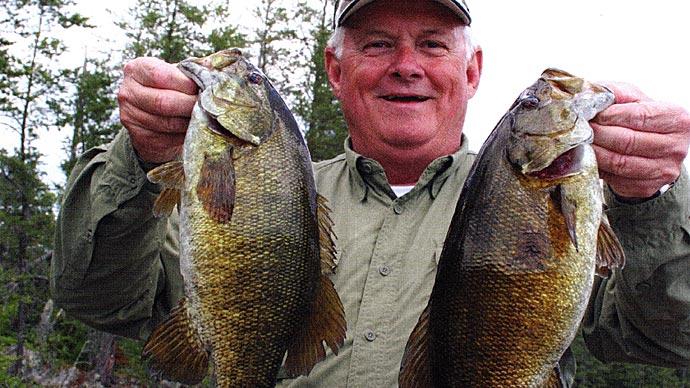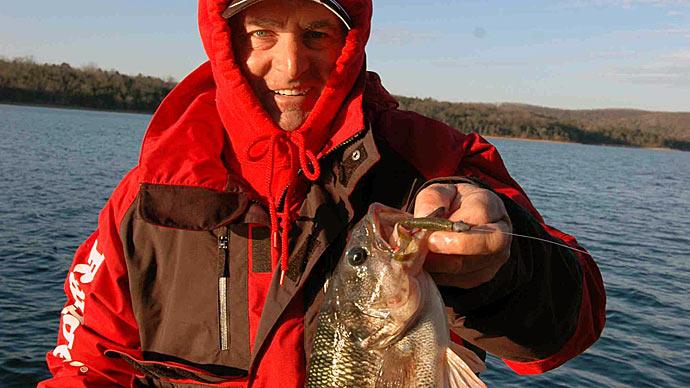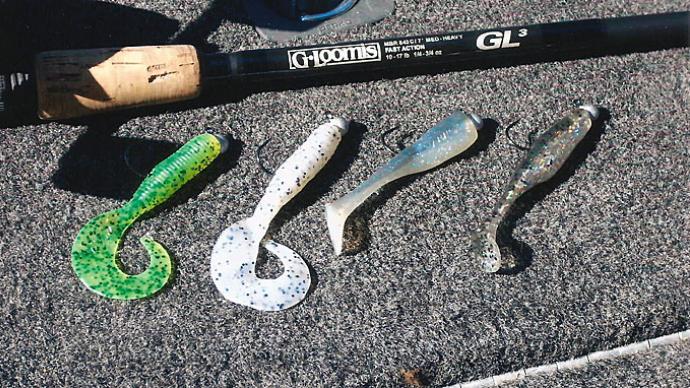
One of the most exciting aspects of Western bass angling is the constant challenge of adapting baits and presentations to the various water conditions we face daily. Angling in the West should never be dull. We have opportunities to take two strains of largemouths, spotted bass, and last, but certainly not least, the smallmouth bass.
My two home lakes offer some of the finest smallmouth angling in the West: Flaming Gorge and Lake Powell. Over the years, I have learned several tricks that have proven successful in any smallmouth haunt and in most conditions ranging from dirty water to clean, shallow to deep. I call these techniques "swimmin' for smallies."
Smallmouth bass love a moving bait. This theory has been proven in my mind countless times over the years. Smallmouths are aggressive fish that seem intent on running down a bait. But they, like other species, suspend at times and become harder to catch.
At some point years ago, I picked up a spinning outfit, tied on a 3-inch grub, and cast it out. Instead of allowing the grub to work its way down the rock piles or to move slowly along the bottom of the spawning flat, I began to reel the grub back much like I would retrieve a spinnerbait. Smallies really liked this approach, and this technique has allowed me to target and catch suspended fish over the years.
Developing this new-found presentation, I found that the action on a 3- to 5-inch curly-tailed grub was plenty to entice a strike. Therefore, I typically use a Yamamoto or Kalin grub and try to get away with as light a weight as possible - 1/8 to 1/4 ounce, depending on the wind.
Swimming a grub can be a deadly search bait. As you move along a shoreline, it is possible to cover roughly the same amount of water that you would if you were throwing a spinnerbait, except you are using a much more subtle presentation. Often, smaller, more subtle presentations are just what the doctor ordered, and the smallies "load up" on it.
Electronics become an invaluable asset when swimming a grub. By charting the cuts, drops, and edges and looking for fish on the graph, you can drop your grub down to the fish quickly and efficiently.
As in any angling, it is essential to "match the hatch." Be sure of the size of forage - crawdads, and baitfish - and use a single-tail grub that matches the size. In my experience, though, smallies rarely refuse a downsized bait.
Grub colors vary, as does a rainbow, but you can always get away with a crawdad color: green pumpkin, watermelon seed, and others. Look at the shad colors too. Once again, try and match the bait the fish are chasing.
There are certain bodies of water, maybe due to water clarity or other factors, in which specific "local" colors are consistent producers. Check with the bait store your destination to determine the best color for your particular destination. It has been my experience that color is secondary to confidence. If you have confidence your bait will catch fish, half the battle is already won.
On the Colorado and Green River reservoirs, jigs have always been produced. I'll often swim a jig with a double-tail grub trailer and find the fish ready and waiting for that presentation. Whether it be a jig or grub, the technique is the same. Fish the bait like a spinnerbait, rarely letting it sit on the bottom. Retrieve your bait with a steady rhythm, and remember to count until you feel you are at a depth of the suspended bass.
The "swimming" tackle is a medium/action spinning rod. I throw a G. Loomis medium action and a Shimano Stradic 6:2 spinning reel. As I've said before, I like 6- and 8- pound test line and a grub head with an excellent sharp hook. I prefer Gamakatsu hooks, Pepper Jigs, and Trilene XL line. Some people swear by painted grub heads, but I don't make it that complicated. The most crucial aspect of the grub head I choose is how it swims.
Rarely is it necessary to Texas rig the grub? The open hook doesn't snag because the technique keeps the bait above grass or rocks. If I do Texas rig, I generally will use it in grass and prefer a Big Boy's tube bait. The nature of swimming a grub or jig is to keep it out of harm's way while enticing suspended smallmouths to strike.
The angling opportunities and challenges in the West make us all better anglers. Pay close attention to the water conditions, depth, clarity, etc., and then tie on a grub or jig and swim for smallies. Oh, by the way, more than a few largemouths have been fooled by a swimming bait. Don't count them out.
Reprinted with permission from Bass West Magazine




